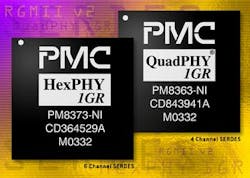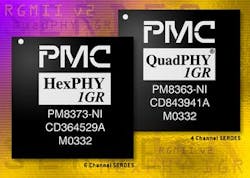PMC-Sierra extends SERDES product family for Gigabit Ethernet backplane and optical module interconnection
26 August 2003 Santa Clara, CA Lightwave -- PMC-Sierra introduced the 6-channel PM8373 HexPHY 1GR and 4-channel PM8363 QuadPHY 1GR serializer/deserializer (SERDES) devices for high-speed serial backplanes and Gigabit Ethernet transceivers. The HexPHY 1GR and QuadPHY 1GR feature support for the Reduced Gigabit Media Independent Interface (RGMII) v2.0 industry standard parallel interface to enable low power, low cost, and compact Ethernet-based system designs.
Both devices use PMC-Sierra's mixed-signal technology to provide signal integrity performance that exceeds IEEE 802.3 Gigabit Ethernet requirements. These devices are designed for a broad range of multi-gigabit serial connections including enterprise Ethernet switches, blade servers, access and metro transport network equipment.
In addition, the devices support the growing adaptation of Gigabit serial technology into office automation, digital imaging, industrial control, and avionics applications. The HexPHY 1GR and QuadPHY 1GR devices' industrial temperature ratings provide robust operation in the most challenging system environments.
RGMII v2.0 simplifies board design by reducing the number of routing layers required, which also lowers board manufacturing costs. RGMII provides greater than 50% signal pin savings over current interface solutions (12 pins versus 25 pins for GMII). To provide flexibility for low power system design, the HexPHY 1GR and QuadPHY 1GR devices support either 1.5V and 1.8V high speed transceiver logic (HSTL) input/output levels on the RGMII interface. In addition, the 1.5V HSTL input/output levels are upward compatible with the IEEE standard 10 Gigabit Ethernet XGMII interface, providing system designers with a seamless migration path from Gigabit Ethernet to 10 Gigabit Ethernet.
The emergence of 1000Base-T copper transceivers in small-form-factor pluggable modules enable system designers to deploy RGMII interfaces in both copper and optical line card applications. Using this approach, equipment manufacturers can develop modular Gigabit Ethernet line card solutions to address IT managers' needs for flexibility between optical and Category 5 copper cable connections thereby eliminating the need to purchase and maintain separate line cards.
The HexPHY 1GR and QuadPHY 1GR devices are sampling to customers, priced at $29.90 and $21.90 for 1K quantities, respectively. Both devices are packaged in a 15x15 mm², thermally enhanced 196-pin chip array ball grid array, have typical power consumption of less than 200 mW per port, and are rated for operation at industrial temperature range (-40° to +85°C). The devices are fabricated using the same low power, 0.18-micron CMOS process proven on multiple PMC-Sierra SERDES products. A comprehensive support product package including datasheets, application notes, device models, and evaluation system is available.
